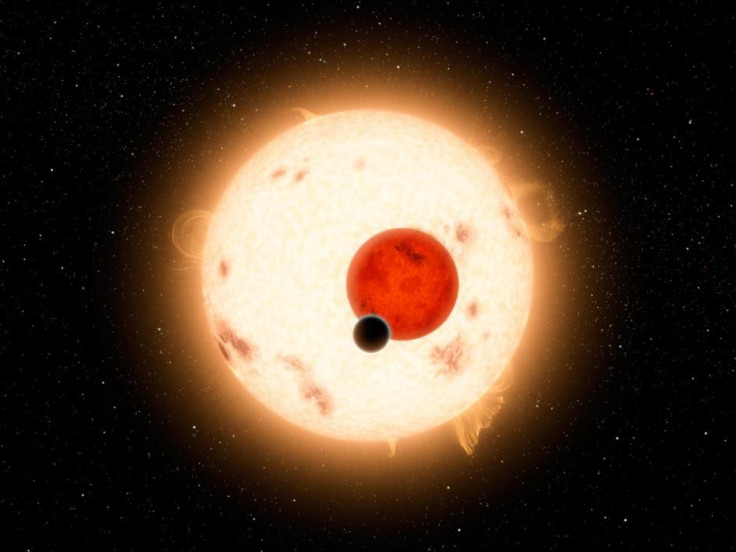NASA Discovers Kepler-16b, a Saturn-sized World With Two Sunsets [VIDEOS & PHOTO]

More than 30 years ago, Tatooine, a world with a double sunset was seen in 'Star Wars,' but today, scientists say such a world exists and that it is called Kepler-16b. But unlike the movie planet, Kepler-16b is cold, gaseous and not thought to be a place that harbors life.
Kepler-16b was seen orbiting two stars, about 200 light-years from Earth.
Scientists say that the discovery of this Saturn-sized, circumbinary planet shows just how much diversity there are among the planets in our galaxy.
Previous research led scientist to believe such a planet may exist. However, they were never able to confirm it until NASA's Kepler mission detected it. Kepler-16b was seen while transits were being observed. This is where the brightness of a parent star dims from the planet crossing in front of it.
This discovery confirms a new class of planetary systems that could harbor life, Kepler principal investigator William Borucki says in a statement. Given that most stars in our galaxy are part of a binary system, this means the opportunities for life are much broader than if planets form only around single stars. This milestone discovery confirms a theory that scientists have had for decades but could not prove until now.
Scientists think the newly discovered planet is made up of half rock and half gas. Of the two stars, one is 69 percent the mass of our sun while the other is 20 percent.
It was a research team led by Laurance Doyle of the SETI Institute in Mountain View, Calif., that made the discovery. The team used data from the Kepler space telescope that measures dips in the brightness of more than 150,000 stars to search for transiting planets.
Kepler finds Earth-sized planets
Kepler is capable of finding Earth-size planets in or near the habitable zone. Habitable zone is the region in a planetary system where liquid water can exist on the surface of the orbiting planet.
Scientists were able to detect Kepler-16b in the Kepler-16 system, which is a pair of orbiting stars that eclipse each other from our vantage point on Earth.
Whenever the smaller star partially blocks the larger star, a primary eclipse occurs. A secondary eclipse happens when the smaller star is completely blocked by the larger star, NASA says.
After 35 years, science fiction has finally become reality, says Alan Boss, a theoretical astrophysicist at the Carnegie Institution for Science in Washington, to Business Week.
Boss is also an author of a study on the planet released earlier this week by the journal Science.
We have been waiting for a long time for one of these to be found, he adds.
Kepler finds more than 1,200 planets
So far, NASA's Kepler mission has found more than 1,200 planets and another 600 have been discovered by ground-based efforts, Boss tells Business Week.
He believes other planets orbiting two suns may soon be detected.
To find these planets seems to take a keen eye.
While observing Kepler-16b, astronomers further saw that the brightness of the system dipped even when the stars weren't eclipsing one another, thus hinting at a third body. Additional dimming in brightness events, called the tertiary and quaternary eclipses, reappeared at irregular intervals of time, showing the stars were in different positions in their orbit each time the third body passed.
This indicated that the third body was circling, not just one, two stars, in a wide circumbinary orbit, NASA says.
The space agency adds that the gravitational tug on the stars, measured by changes in their eclipse times, was a good indicator of the mass of the third body.
Only a very slight gravitational pull was detected ? one that could only be caused by a small mass, according to NASA.
Most of what we know about the sizes of stars comes from such eclipsing binary systems, and most of what we know about the size of planets comes from transits, Doyle says. He is the lead author and a Kepler participating scientist. Kepler-16 combines the best of both worlds, with stellar eclipses and planetary transits in one system.
Can't Live the Jedi life there
But don't go packing your belongings thinking you can start living the Jedi life any time soon, as NASA says the discovery confirms that Kepler-16b is an inhospitable, cold world that is about the size of Saturn thought to be made up of about half rock and half gas.
The parent stars of this planet are smaller than our sun. In fact, one is 69 percent the mass of the sun and the other only 20 percent.
Additionally, Kepler-16b orbits around both stars every 229 days, which is similar to Venus' 225-day orbit, but lies outside the system's habitable zone, where liquid water could exist on the surface, because the stars are cooler than our sun.
Working in film, we often are tasked with creating something never before seen, says visual effects supervisor John Knoll of Industrial Light & Magic, a division of Lucasfilm Ltd., in San Francisco, in a statement. However, more often than not, scientific discoveries prove to be more spectacular than anything we dare imagine. There is no doubt these discoveries influence and inspire storytellers. Their very existence serves as cause to dream bigger and open our minds to new possibilities beyond what we think we 'know.'
The below artist's movie illustrates Kepler-16b, the first directly detected circumbinary planet, which is a planet that orbits two stars.
This artist's animation illustrates the Kepler-16 system from an overhead view, showing the eccentric orbits of the two stars as they twirl around each other every 41 days like figure skaters.
© Copyright IBTimes 2024. All rights reserved.






















